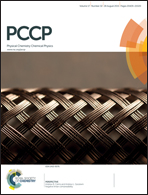Theoretical study of the pathway to heterogeneous nucleation of liquid copper on the groove substrate with different wedge angles
Abstract
Heterogeneous nucleation is of significance in controlling the crystal growth, but the key route is still limited. Simulations are performed to explore the microscopic details of how the wedge substrate spreads its structural information to a growing crystal and further affects the solidification process. The simulation results show that, owing to the induced effect from the substrate, the copper atoms become layered at the liquid–solid interface in a “V”-shaped pattern and tend to form a twin crystal. The structural information delivery of the substrate decays with the distance away from the substrate, and the final solidified structure would gradually recover its inherent structure. Interestingly, the wedge angle of 90° seems to be an exception at which the solidified structure exhibits a perfect crystal due to the nearly perfect match with the Cu atoms. Moreover, the cooling rate and the atomic structure of the substrate are also found to have striking correlations with the final structures. These research results are favorable for a better understanding of the inherent relation between the solidified structure and the substrate.


 Please wait while we load your content...
Please wait while we load your content...